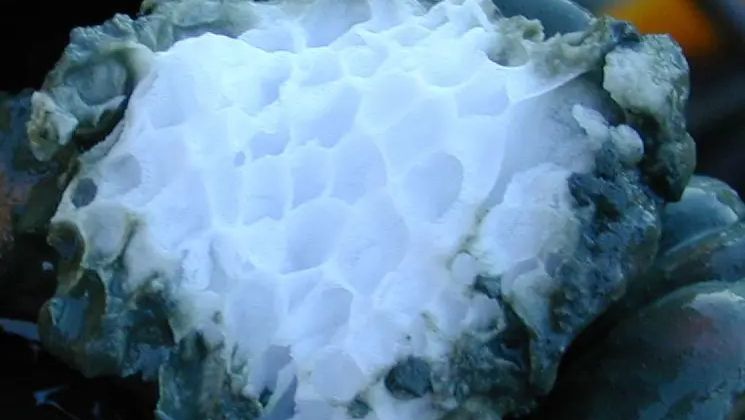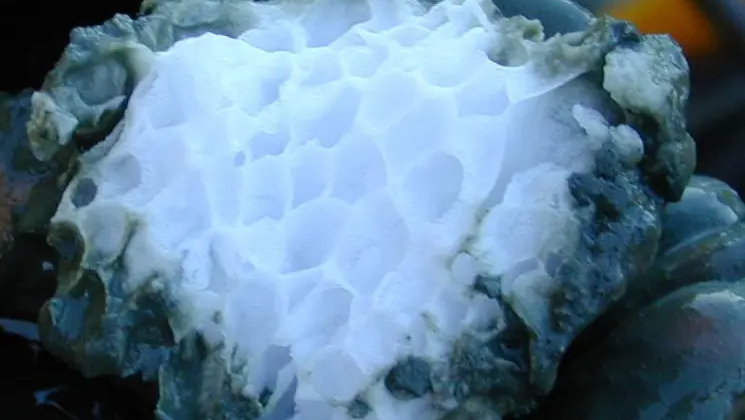
[ad_1]

On Earth, massive amounts of methane are trapped within white, cage-like chemical structures. These deposits are primarily found in permanently frozen polar regions as well as on the seafloor, but the key here is that they’re not specific to our planet. Similar reservoirs are known to exist on bodies across the solar system — from planets and their moons to comets zipping by. And even though scientists think such deposits ultimately influence the composition of these worlds’ ocean waters and atmospheres it remains an open question whether they arise from biological processes. Many experts have long wondered how those methane cages remain stable under high-pressure ocean water conditions.
Now, a team of researchers studying one of these methane deposits — plucked from the seafloor off the coast of Oregon — have discovered a previously unknown class of proteins that seems to play an important role in stabilizing the structure of the deposits.
“We wanted to understand how these formations were staying stable under the seafloor, and precisely what mechanisms were contributing to their stability,” Jennifer Glass, who is a professor in the School of Earth and Atmospheric Sciences at Georgia Institute of Technology and a co-author of the new study, said in a statement. “This is something no one has done before.”
Related: Methane ‘super-emitters’ on Earth spotted by space station experiment
On Earth, solid ice-like deposits known as methane clathrates form when microorganisms in ocean waters convert organic materials, like remnants of plankton, into methane, which then gets trapped in cages. These deposits transform into gas over time and rise upward. During this process, a variety of organisms start feasting on the methane. Eventually, the chemical is released into the atmosphere. But in regions like the Arctic, where water is warming faster than the rest of the planet, large amounts of methane escape ocean waters before those biological communities can consume them.
“These deep microbes encode genes that are different from any found on the Earth’s surface,” Glass had previously said when the research had begun with support from the NASA Exobiology Program. “This project gives us the opportunity to unravel microbial survival strategies at extreme conditions, understand the roles of microbes in the fate [of] methane in hydrate reservoirs, and expands our research capability.”
To better understand methane clathrates, researchers behind the new study identified the genes of the proteins present in the sediment. Then, the proteins were recreated in the lab for further analysis. To test those proteins, the team also produced methane clathrates in the lab by recreating the high pressures and low temperatures found on the seafloor. A unique pressure chamber mimicking seafloor conditions was built from scratch and used to measure how much gas the clathrate consumed in a certain time, which shed insight on how quickly it formed, according to the new study.
Results showed a class of proteins called the bacterial clathrate-binding proteins (CbpAs) influenced the growth of clathrate by interacting directly with its structure. Proteins with antifreeze characteristics like those that help fish survive in colder temperatures stabilized the clathrate structure, scientists say.
“We were so lucky that this actually worked, because even though we chose these proteins based on their similarity to antifreeze proteins, they are completely different,” Abigail Johnson, a postdoctoral researcher at the University of Georgia who had formed methane clathrates in the lab for the new study, said in a recent statement. “They have a similar function in nature, but do so through a completely different biological system, and I think that really excites people.”
Elsewhere in the solar system, previous research has suggested methane on Mars originates from hydrothermal reactions.
On Titan, which is Saturn‘s largest moon, scientists think the gas originated from its building blocks since the early solar system. Saturn’s moon Enceladus and Jupiter‘s Europa, arguably the current best places to search for life, are thought to host methane clathrates as well.
Findings from the new study suggest that if microbes exist on other worlds, they might create similar molecules to create and stabilize methane clathrates, which in turn affects the composition of ocean waters and the atmospheres of those worlds.
Thus, to find alien life, maybe we need to follow the methane clathrate trail.
The research is described in a paper published last month in the journal PNAS Nexus.
[ad_2]